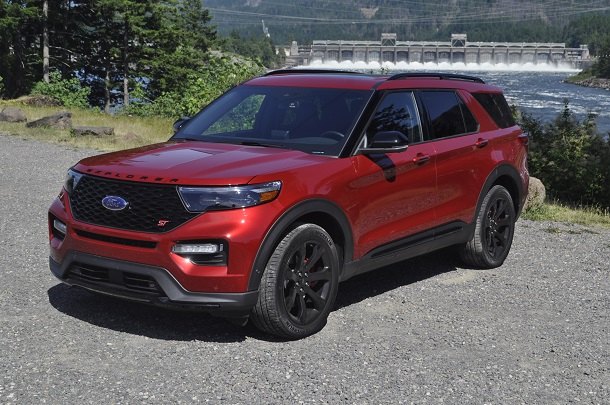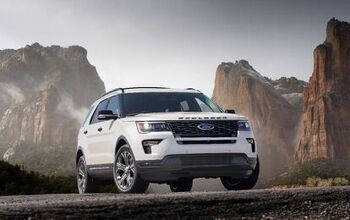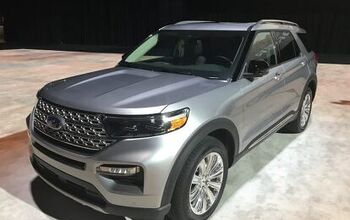First Drive: 2020 Ford Explorer - Premium Pricing

For four generations, Ford offered the Explorer with rear-wheel drive as standard. It went front-drive for the fifth.
Now, the standard drivetrain is rear-drive again. Back to basics, so to speak.
Except, not really. First-gen Explorers didn’t have infotainment systems, or 10-speed automatic transmissions, or available hybrid powertrains. Those staples of modernity have been added over the years.
Whether it was out of nostalgia or an attempt to capitalize on the resurgence of dinosaur-themed tent-pole cinema, or simply an attempt to make us overfed journos get a quick guffaw, Ford PR trotted out an early ‘90s example, complete with Jurassic Park livery, for us to gawk at (rumor has it we may be able to get behind the wheel someday. Fingers crossed). I opened the door and was greeted with what was the new-car smell of my youth. This Explorer needed no 10-speed, no Sync, no hybrid, to charm. Could the 2020 version do the same as it returned to a rear-drive base?
(Full disclosure: Ford flew me to Portland, Oregon, put me up in a nice hotel nearby in Washington state, fed me, and sent me home with a coffee mug.)
Ford is offering choice aplenty this go-round, with two gas powertrains and a hybrid unit (a first for Explorer). Trims include base, XLT, Limited (hybrids are only available in Limited trim), ST, and Platinum.
The event flow of this particular press drive meant I got several hours of seat time in the ST, supplemented by short loops in the 2.3-liter four-cylinder, the hybrid, and the Platinum, with one more spin in an ST for pics.
Replacing the Sport model, the ST offers up 400 horsepower and 415 lb-ft of torque from a 3.0-liter turbocharged V6 that pairs with a 10-speed automatic. I’m starting with the ST since I happened to have spent the most wheel time in one.
The performance-oriented ST does feel quick relative to its size, and it handles well given the size and weight here (over 4,700 lbs, although Ford has worked to slim down the Explorer by a couple hundred pounds compared to the previous generation.). It’s no sports car, duh, but it’s entertaining enough to make the parent who traded in his/her Mustang feel a little less remorse. The steering is well-weighted, although feel is artificial. The soundtrack is surprisingly great, but much of the exhaust noise is sadly as fake as the news from that Web site your uncle keeps sharing on Facebook. The brakes do the trick well enough on a hilly, curvy backroad.
The ST I wheeled around Oregon and Washington was equipped with available 21-inch wheels and “performance” brakes. High-performance brakes are also available.
All-wheel drive is standard on ST models. Popping it into sport mode (other modes include normal, eco, trail, deep snow and sand, slippery, and tow/haul) does up the verve factor somewhat, and that seems to be the case across the board, but obviously more so in the ST.
It’s also standard on the Platinum, which uses the same V6 with lower power numbers: 365 horsepower and 380 lb-ft. On the road, the Platinum doesn’t feel that much slower than the ST, despite being a tad heavier. It’s ride and handling isn’t quite on par with the ST, but it’s not too far off.
Dropping down to the 2.3-liter EcoBoost inline-four with rear-wheel-drive, the change in experience is predictable. For obvious reasons, it’s lighter than the Platinum or ST, but it didn’t feel quite as dialed in on the back roads as the higher-powered six-cylinder trucks. With 300 horsepower and 310 lb-ft of torque, it’s definitely not quite as quick to get rolling, but it’s still got enough punch for commuting duty.
The hybrid, mating a 3.3-liter naturally aspirated V6 to an electric motor for 318 combined system horsepower and 322 lb-ft of torque, serves up a similar driving experience to the rest, although it’s the least button-downed in terms of handling. The steering feel in both the Hybrid and the XLT felt even more artificial than in the upper trims, with less weight. Feedback is almost nil in the lower trims.
Speaking of handling, all trims displayed the body roll one would expect in a large crossover, although the ST unsurprisingly tamped it down the best, with the Platinum not far behind. Regardless of trim, the Explorer will ride, handle, accelerate, and brake well enough to satisfy most of suburbia, with the ST presenting a little more flair.
Ford did setup an off-road course to show that the Explorer is capable of playing in the dirt, but it was pretty easy-peasy. Still, I learned that the Explorer can ford (sorry) a decent amount of water. I doubt any owner will use their Explorer to tackle any truly tough terrain, but it will handle light off-roading just fine.
Outside, the look is familiar but more aggressive, and it’s handsome. I especially like the blacked-out grille and wheels of the ST and the rakish look from the rear doors back. The headlights swoop back towards the windshield in such a way that the Explorer appears to have a prankster’s evil smirk when viewed from some angles.
Inside, the dashboard has nice curves that are marred by the infotainment system, which feels like an afterthought in both eight-inch and 10.1-inch size. I often carp about the tacked-on feel of so many of today’s infotainment screens, but this one literally looks like a tablet taped to the dash. I might be willing to live with the looks if the screen was easy to read at a glance, but there’s too much info displayed to allow for quick scanning, even though the font is large and legible.
It also would’ve been better if the navigation system didn’t steer us wrong at several points. I’m not the only journalist who was directed off the freeway by the nav, only to be sent right back onto the on-ramp for the same freeway, heading in the same direction. Ford promised us this was an early production glitch that will be fixed via software update.
The Explorer is slightly longer than the Hyundai Palisade, with less leg room and similar head room, and a tiny bit more cargo room beyond the third row. It’s a similar story when compared to Kia’s Telluride, but the Kia bests both for cargo volume behind the third row.
An available 12.3-inch digital gauge cluster looks cool, is easy to read, and provides neat little animations when you switch drive modes. It’s just too bad that both screens ruin the look of an otherwise handsome cabin.
Available features, depending on trim, including power liftgate (with foot activation available), 18-inch wheels, 20-inch wheels, 21-inch wheels, Sync infotainment, navigation, digital gauge cluster, tri-zone climate control, push-button start, LED lighting, blind-spot information system with rear cross-traffic alert, lane-keep assist, pre-collision assist with automatic emergency braking (which includes pedestrian detection, forward-collision warning, and what Ford calls Dynamic Brake Support).
We’re not done. There’s more: Apple CarPlay, Android Auto, evasive steering assist, in-car Wi-Fi, 360-degree camera, trailer-sway control, dual chrome exhaust tips, LED fog lamps, rear climate control, heated steering wheel, rain-sensing wipers, capless fuel filler, remote keyless entry, premium audio, second-row captain chairs (with available heating), moonroof, leather seats, hill-descent control, satellite radio, and park assist.
Not all models have been through the EPA testing yet, but a quick search of the gubmint’s official FE site shows the rear-drive 2.3 at 21 mpg city/28 mpg highway/24 combined and the AWD version is 20/27/23. One of the V6s (presumably, the Platinum version, but I suppose it could be the ST, or both. Seriously, EPA, add a trim selector to FE.gov, huh? It’s 2019) is listed at 18/24/20.
One problem is the price. Base models won’t even be available for six months, and while the XLT I drove started at a reasonable $36,375 but, with options ladled on (tow package, driver-assistance tech, LED fog lamps, remote start) and the $1,095 destination fee factored in, the register rang at $43,115.
It doesn’t get better from there. The Limited Hybrid I drove? Nearly $60K with 20-inch wheels and the tow package, along with upgraded brakes. Starting price was $52K. The similarly-equipped STs (both had the twin-panel moonroof, performance brakes, Street Pack package, 10.1-inch infotainment screen, and premium audio) started around $54,000 and came within a whisker of $60,000 with options.
The Platinum I drove with 21-inch wheels, premium audio, and 10.1-inch infotainment system? Over $58K to start, and $61K with those and other options factored in.
Woof.
Unless I am missing something, I can’t go online and build and price a competing Kia Telluride or Hyundai Palisade to over $50K, even ticking all the boxes on the Web site. To be fair, neither offers a hybrid. But Toyota’s Highlander does — and it took a lot of clicks to get that to $53,000.
That’s the big problem the Explorer faces. It looks good outside and the interior only suffers from one major blemish. It drives reasonably well in lower trims, despite steering that doesn’t communicate and some body roll. The Platinum is a step up, and the ST is about as sporty as a mainstream SUV this size can reasonably get.
That price tag, though. It’s true we’re working off of MSRP here, and incentives may change things down the line. Still, the Telluride and Palisade (review forthcoming) are both better all-around crossovers offering much of the same content for a lower price, even if they don’t offer performance versions or hybrid models.
The ST does stand out a bit, as it has no natural competitor other than perhaps the Dodge Durango R/T (the Durango SRT is a level above, performance-wise). Ford is trying to position it as a value alternative to sport/luxury SUVs bearing badges like Land Rover or Range Rover, but will the Beverly Hills set even look at a Ford dealer as they pass?
On its own merits, the Explorer is a pretty good crossover. While enthusiasts might need to purchase the ST or Platinum to feel fully satiated, the 2.3 and Hybrid offering up a pleasant enough driving experience that will pass muster with most crossover shoppers not looking to drop the hammer.
As noted above, the problem is the money. With Kia and Hyundai offering screaming values while shedding their past baggage faster than members of the Windsor ballet shed clothes, Ford has an uphill battle ahead of it, methinks.
That’s a shame, because this new Explorer is quite likeable. Just not premium-price likeable. I did some Googling — a mid-trim 1990 Explorer tested by Car and Driver cost $22,115, or about $43,000 today. Slightly more than the optioned-out 2020 XLT I tested. That’s pretty reasonable.
Makes me miss that early ‘90s version even more.
[Images © 2019 Tim Healey/TTAC]

Tim Healey grew up around the auto-parts business and has always had a love for cars — his parents joke his first word was “‘Vette”. Despite this, he wanted to pursue a career in sports writing but he ended up falling semi-accidentally into the automotive-journalism industry, first at Consumer Guide Automotive and later at Web2Carz.com. He also worked as an industry analyst at Mintel Group and freelanced for About.com, CarFax, Vehix.com, High Gear Media, Torque News, FutureCar.com, Cars.com, among others, and of course Vertical Scope sites such as AutoGuide.com, Off-Road.com, and HybridCars.com. He’s an urbanite and as such, doesn’t need a daily driver, but if he had one, it would be compact, sporty, and have a manual transmission.
More by Tim Healey
Latest Car Reviews
Read moreLatest Product Reviews
Read moreRecent Comments
- Blope Cataluna Red Audi Etron and a Red Golf TDI Wagon
- Vulpine Considering the size of modern full-sized pickup, they NEED the ability to "squat" just to be able to load/unload them from the rear. It's a law that needs to be contested for the utility of the capability, despite the fact that... yes, it can be abused by show--offs.
- SCE to AUX I have two bright blue Hyundais at the moment, and I've only had one red car.I think I've had 7 white cars. My very first car was orange.A friend once said he buys the ugliest, or most garish color on the lot, to try and get a better price on a dealer dud. It also makes the car easier to spot in a sea of gray vehicles. I couldn't do that, but I see the logic.
- Bd2 For the medium to long term, not much as other automakers are building out their own charging network whether via the consortium or on their own (some, like Mercedes are doing both).
- ToolGuy Let's count the poor decisions: Honda 18 model years past peak Honda. Ohio. Following too closely ('rock on the highway' doesn't leap up and attack your vehicle by itself, it is riding on a vehicle or thrown up by a vehicle, and you should be alert to this). Ohio. Not enough doors. Choosing to expand family -- in Ohio. 😉 Also not great at math.Engine bay picture: At least take a shower before your glamour shot lol.








































Comments
Join the conversation
So "a mid-trim 1990 Explorer tested by Car and Driver cost $22,115, or about $43,000 today. Slightly more than the optioned-out 2020 XLT I tested. " but yet it's overpriced? head scratch. Anything over 20k is considered "overpriced" on TTAC. lol.
There is an issue Ford buyers MUST be made aware of. I have purchased TWO 2020 Ford Explorers and had the exact same issue with both (one broke down with the same repair twice, replacement car once). The production numbers on the two vehicles were significantly different, which leads me to believe the problem is endemic. It takes up to 10 weeks to receive the parts, which means Ford is having this problem nationwide. The issue is the transmission oil cooler, which fails after approximately two solid hours of driving. I had failure on the exact same part at under 2000 miles, again at 5300 miles, and on a brand new replacement vehicle at 1021 miles. If the driver is unaware of the transmission oil cooler failure, the transmission fails as well. The consumer who purchases this vehicle and just does a short commute to work probably won't see the failure until a vacation or similar extended trip. I have documents to prove this, and a list of the dealerships involved. The problem was never the dealers, who tried to help, but Ford Corporate, which won't acknowledge the issue.